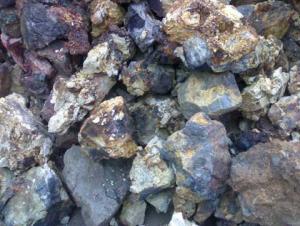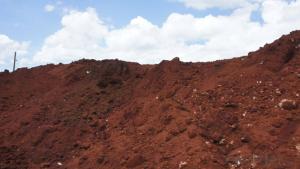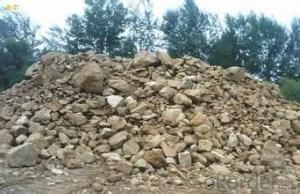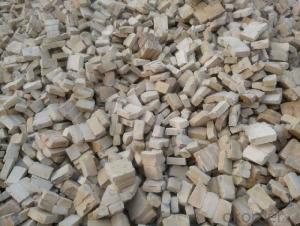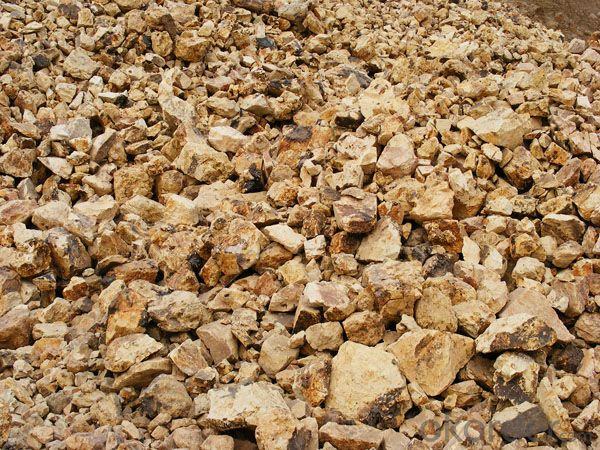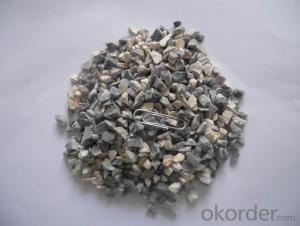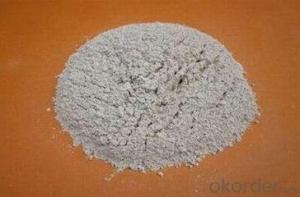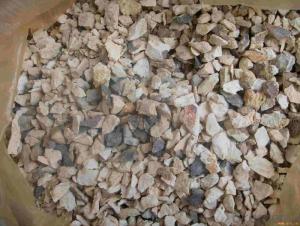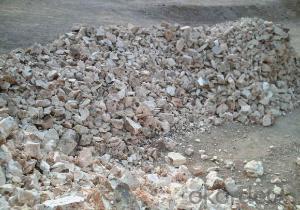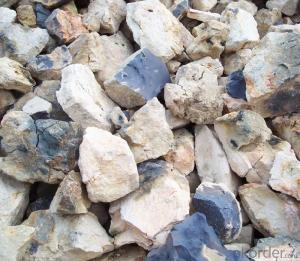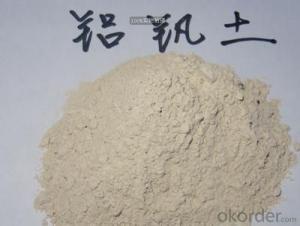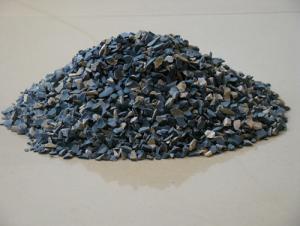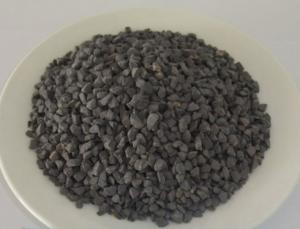ISO Certified Alumina Bauxite Raw Materials for Refractory - Fine Dust of CNBM in China
- Loading Port:
- Tianjin
- Payment Terms:
- TT OR LC
- Min Order Qty:
- 1 m.t.
- Supply Capability:
- 10000000 m.t./month
OKorder Service Pledge
OKorder Financial Service
You Might Also Like
1.Structure of Calcined Bauxite Description
Bauxite (aluminous soil; Bauxite) is also called the alumina or bauxite, main ingredients are alumina, hydrated alumina containing impurities, is an earthy mineral. White or gray, brown and yellow or light red by iron. From 4 to 3.9 g/cm3 density, hardness, 1 ~ 3 is not transparent, very brittle. Very difficult to melt. Insoluble in water, soluble in sulfuric acid, sodium hydroxide solution. Mainly used for aluminium, refractory material.
2.Main Features of the Calcined Bauxite
Calcined bauxite is one of the principal ore of aluminum. Calcined bauxite contains hydrous aluminum oxides and aluminum
hydroxides, formed through the laterization of aluminous rocks in tropical and subtropical areas .Calcined bauxite is obtained by calcining (heating)superior grade bauxite at high temperature (from 85OC to 1600C) .This removes moisture there. By increasing the alumina content,compared to an alumina content of about 57%to 58% in raw bauxite, calcined bauxite has an alumina content of 84%to88%.The heating is carried out in rotary kilns.
3. Calcined Bauxite Images

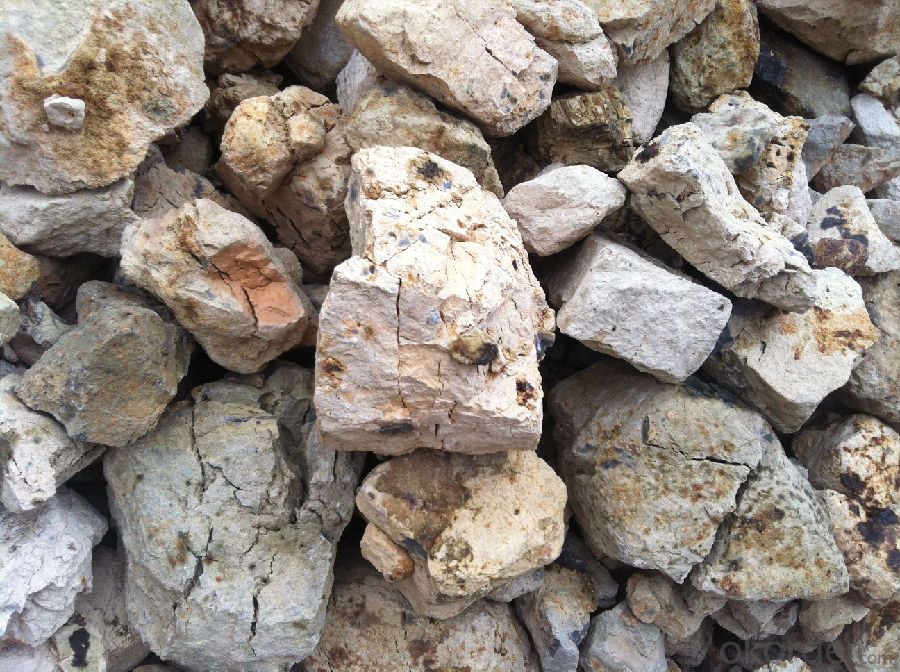
4. Calcined Bauxite Specification
items | Chemical composition % | Water absorption % | Bulkdensity g/cm3 | |||
Al2O3 | Fe2O3 | CaO+MgO | R2O | |||
Special grade ONE | ≥85 | ≤1.8 | ≤0.4 | ≤0.4 | ≤3 | ≥3.10 |
Special grade TWO | ≥80 | ≤2.0 | ≤0.5 | ≤0.5 | ≤5 | ≥2.90 |
Grade ONE | 70-80 | ≤2.0 | ≤0.6 | ≤0.6 | ≤5 | ≥2.75 |
Grade TWO | 60-70 | ≤2.0 | ≤0.6 | ≤0.6 | ≤6 | ≥2.65 |
particle size
name | Particle size | limit |
High alumina bauxite | 10~5mm | >10,<5 less than 10% |
High alumina bauxite | 5~3mm | >5,<3 less than 10% |
High alumina bauxite | 3~1mm | >3,<1 less than 10% |
High alumina bauxite | 1~0mm | <1 less than 10% |
High alumina fine dust | 0.08mm | Screen residue less than 10% |
High alumina fine dust | 0.045mm | Screen residue less than 10% |
5.FAQ of Calcined Bauxite
1). Q: Are you a factory or trading company?
A: We are a factory.
2). Q: Where is your factory located? How can I visit there?
A: Our factory is located in ShanXi, HeNan, China. You are warmly welcomed to visit us!
3). Q: How can I get some samples?
A: Please connect me for samples
4). Q: Can the price be cheaper?
A: Of course, you will be offered a good discount for big amount.
- Q: What are the materials of insulation firebricks?
- The furnaces of firebricks are generally divided into two types, namely, unshaped refractory materials and shaped refractory materials. Unshaped refractory materials, also called castables, is a mix of powdery particles of many aggregates and one or multiple adhesives. They must be stirred well with one or multiple liquids when in use, which has a strong liquidity. Unshaped refractory materials generally refers to firebricks. They have standard rules about their shapes and can also be processed temporarily as needed.
- Q: Does anyone know the difference between refractory and thermal insulation material?
- Refractory refers to inorganic nonmetallic material, whose refractorinessis not less than 1,580℃, but refractory is not necessarily insulated material. Inorganic thermal insulation material also belongs to refractory as long as its refractoriness is higher than 1580℃.
- Q: Urgent question: could you tell me that the export of refractory materials to Vietnam is to be packed in wooden cases and smoked?
- Solid wood logs are necessary. If it is the type of smoke free material, it will not be necessary. You'd better confirm it with the port of destination. Vietnam has the requirement to smoke
- Q: How long is the duration of fire resistance of hollow glass magnesium board
- Hollow glass magnesium board features fire prevention, waterproof, tasteless, non-toxic, not frozen, not rot, not crack, unchanged, non burning, high strength and light weight, convenient construction, long service life and so on, and it has more characteristics among products of the same kind nationwide. Its fire resistance limit is 0.65℃.
- Q: What do we mean by saying that a ladle cover knots, elbow knots, blowpipe knots in refractory materials? What is the “knot”?
- Go eastward 200 meters from the south gate of cultural square.
- Q: How long is the duration of fire resistance that fireproof door of level B can endure?
- The national standard for fireproof door of level B is 1.5h, which must be achieved. The data GB12955-2008 means that the door leaf of raw material is 0.8mm-1.2mm in thickness and door frame is 1.2mm-1.5mm in thickness. And other metal melting temperature shall not be less than 950℃, the duration of fire resistance shall not be less than 0.9 hours. Fire department will check and accept based on the manufacturer's inspection report, so you have to refer to manufacturer's inspection report if you want to know more in detail.
- Q: who knows how to classify the fire resistant levels of fireproofing material?
- Materials used in construction are called construction materials. The combustion performance of construction materials refers to all physic and chemical changes happened when burning or contacting fire, the properity is measured by combustibility of material surface and flame transmission, heating, smoke,charring, weightlessness, and the producing of toxicity resultant. Our national standard GB8624-97 classifies the combustion performance of construction materials into following several levels. Class A: Incombustible building material, class B1: Nonflammable building material, class B2: Combustible?building?materials, class B3: Inflammability construction materials, generally speaking: first fire resistant level construction is the mixed construction of reinforced concrete structure or brick wall and steel concrete structure; second fire resistant level construction is the steel structure roof truss, reinforced concrete column or mixed structure made by brick wall; third fire resistant level construction is the wood and brick made by wooden roof and brick wall; fourth fire resistant level one is the combustible?structure made by wooden roof, hard-comnustible component wall.
- Q: How many grades of fire?rating are there for interior decoration materials?
- It can be divided into construction classification and fire resistance rating. Fire prevention for buildings. Fire prevention measures should be taken in the architectural design to prevent fires and reduce fire hazards to life and property. Building fire protection includes two aspects: fire prevention before fire disaster and measures in fire disaster, among which the former is mainly to confirm the fire resistant rating and fire-resistant structure.
- Q: what needs to be noted when choosing and using blast furnace fireproof materials?
- Hello,: three parts of the blast furnace lining in general are easily corroded. The first one is furnace bosh,second is the middle part of the furnace, The third is lower part of the furnace stack. if These parts are damaged, then we need an overhaul. Bosh, because damage to the middle part of the furnace and the furnace bosh are generally due to alkali metal and fusant erosion. the main reason for the lower furnace part damage is molten iron, slag. In view of this situation, mullite bricks, corundum bricks, silicon carbide bricks are used for reparation. make repairments as soon as possible if any problems occur in case of incidents.
Send your message to us
ISO Certified Alumina Bauxite Raw Materials for Refractory - Fine Dust of CNBM in China
- Loading Port:
- Tianjin
- Payment Terms:
- TT OR LC
- Min Order Qty:
- 1 m.t.
- Supply Capability:
- 10000000 m.t./month
OKorder Service Pledge
OKorder Financial Service
Similar products
Hot products
Hot Searches
Related keywords
